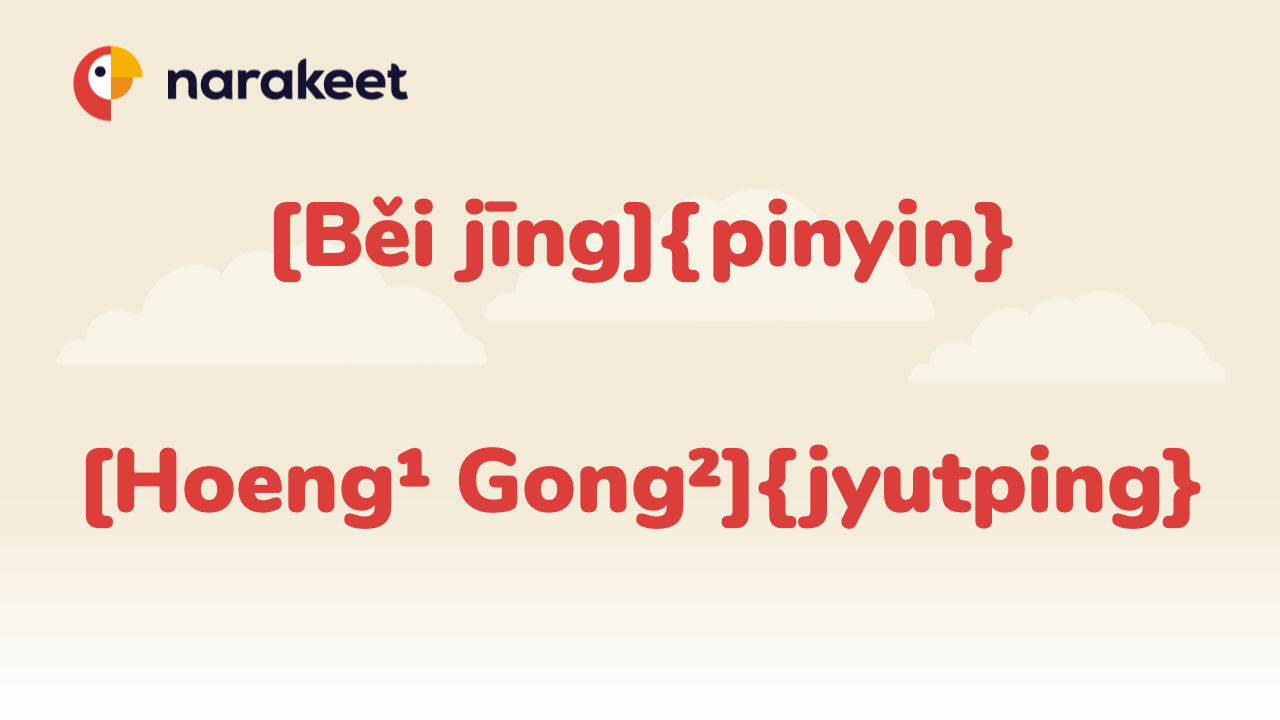Using Pinyin and Jyutping phonemes to modify Chinese language pronunciation
Specify phonetic pronunciation for custom terms, invented words and brand-names with Chinese language voices. Narakeet allows you to use two standard systems for phonetic spelling of Chinese words, Pinyin and Jyutping, to define precise sound mappings for words. These definitions override default text-to-speech rules to eliminate ambiguity, or force a specific pronunciation.
This ensures that unique or specialized vocabulary is spoken clearly and consistently for unusual or rare words, even if the AI voices have not been trained to read some specific terms. Phonetic support enables you to define how to read place names, personal names or company brands, even for invented words.

What is Pinyin?
Pinyin is the official romanization system for Standard Mandarin, using the Latin alphabet to represent Chinese sounds. Pinyin uses diacritical tone marks (ˉ ˊ ˇ and ˋ) to indicate Mandarin’s 4 tones (plus neutral tone). It helps with pronunciation, learning tones, and inputting Chinese characters on digital devices. It is widely used in education, dictionaries, and language learning worldwide. Pinyin is official in mainland China, globally dominant in Mandarin teaching, dictionaries, and typing systems.
Pinyin syllable combinations consist of initials (typically consonants), finals (vowels or compound vowels) and tones. For example,
the name of the Beijing city in Mandarin contains two syllables. The first is bei (initial b, final ei in third tone), the second is jing (initial j, final ing using the first tone). With diacritics for tones, the Pinyin romanization is Běi jīng.
How to use Pinyin with Narakeet?
To specify Pinyin pronunciation with Narakeet, replace the word or phrase in the script with a narration span ([]{}). Put the Pinyin text into the square brackets, and follow it with the style specification pinyin in the curly braces). You must provide entire syllables, with spaces in between.
Here is an example:
(voice: daoming)
[Běi jīng]{pinyin}
Accented letters are sometimes difficult to type, especially on mobile devices. Instead of accented vowels, you can also specify the tones as numbers. To use numeric tone support, do not use accents over the vowels, but just put the tone number after the syllable. You can write the tone number directly after the syllable, or put a space in between for easier reading. If you use spaces between the syllables and tones, then also separate the syllables with a dash.
(voice: daoming)
[bei3 jing1]{pinyin}
[bei 3 - jing 1]{pinyin}
What is Jyutping?
Jyutping is a romanization system for Cantonese. It uses the Latin alphabet combined with numbers to represent Cantonese sounds and tones accurately. Jyutping is widely used in teaching Cantonese pronunciation, dictionaries, and digital input methods, offering a standardized alternative to older systems like Yale romanization. Unlike Pinyin, it does not use diacritical marks or accented letters to specify tones, but uses numbers after syllables for tonal guidance. Tones are usually specified as superscripts after the syllables.
For example, the name of the Hong Kong city contains two syllables in Jyutping: Hoeng¹ Gong². The first of these syllables uses tone 1. The second uses tone 2.
How to use Jyutping with Narakeet?
To specify Jyutping pronunciation with Narakeet, replace the word or phrase in the script with a narration span ([]{}). Put the Jyutping text into the square brackets, and follow it with the style specification jyutping in the curly braces). You must provide entire syllables, with spaces in between.
(voice: man-chi)
[Hoeng¹ Gong²]{jyutping}
Superscripts can be difficult to type on some keyboards, so you can also just use regular numbers.
(voice: man-chi)
[hoeng 1 gong 2]{jyutping}
To improve readability, you can join the tone number and the syllable, or optionally use a dash to separate the syllables more clearly:
(voice: man-chi)
[hoeng1 gong2]{jyutping}
[hoeng 1 - gong 2]{jyutping}
Testing the pronunciation
We recommend that you verify the pronunciation using the Preview function.
Important limitations
The key important limitation for both Pinyin and Jyutping is that you need to provide entire syllables, separated by spaces or dashes in between. Using just initials or finishers (e.g. specifying just consonants b) is not supported. Using syllables joined together is also not supported.
The other important limitation is that only certain voices support Pinyin and Jyutping. Check the list below for more information.
Supported voices
The following voices voices support Pinyin phonemes:
- Baihe
- Bo
- Chao
- Cheng
- Daoming
- Dawei
- Guochao
- Hanyu
- Hetang
- Hua
- Jianbin
- Jianhua
- Jing
- Jueming
- Liying
- Luodan
- Mei
- Mengyao
- Minghao
- Quan
- Shuang
- Wei
- Xiaoming
- Xinyan
- Xinyi
- Yifei
- Yuqi
- Zihan
- Ziwen
The following voices voices support Jyutping phonemes:
- Kong-sang
- Man-chi
- Wing-yi
To check if a voice supports Pinyin or Jyutping, you can try one of the examples above with that voice using Previews.